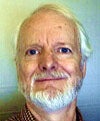
Friesen, Wolfgang O.
Primary Appointment
Professor, Biology
Education
- BA, Physics, Bethel College
- MA, Physics, University of California, Berkeley
- PhD, Neuroscience, University of California, San Diego
- Postdoc, Neurobiology, University of California, Berkeley
Contact Information
PO Box 400328
Gilmer Hall Room, 283a
Telephone: 434-982-5493
Email: wof@virginia.edu
Website: http://www.people.virginia.edu/%7Ewof/home.html
Research Disciplines
Neuroscience
Research Interests
Neuroethology of animal locomotion
Research Description
Overview: Our primary research goal is to identify and describe the neuronal mechanisms that underlie animal behaviors. We concentrate on rhythmic movements, which are particularly tractable for such studies. The neuronal systems that control movement comprise central oscillators, which are circuits of interneurons (sometimes including motor neurons) located within the central nervous system; output via motor neurons and muscles; and sensory receptors that modify and adapt the central neuronal pattern to the specific structure of the animal and to its environment. We are studying the relatively simple movements (swimming) of one favorable invertebrate, the medicinal leech, which serves as a model system for analyzing the neuronal mechanisms that generate and control animal movements. This preparation is particularly suitable system for studying in detail the origin of neuronal oscillations. Previous research on the neuronal mechanisms controlling leech swimming activity has led to detailed descriptions of the neuronal circuits underlying leech swimming movements. Identified levels of organization include sensory neurons, gating neurons that provide excitatory drive to the oscillator interneurons, interneurons that generate the oscillations, and motor neurons. With our discovery of the trigger neurons, there now exists a delineated, neuronal pathway for the control of leech swimming movements, consisting of monosynaptic interactions between identified neurons. This pathway begins with sensory receptors, includes trigger neurons, gating neurons and oscillator interneurons, and ends with the motor neurons. Thus five hierarchical neuronal levels control leech swimming movements.
The role of sensory feedback in generating the leech swimming rhythm: We are investigating the role of sensory input in shaping the output of previously identified neuronal oscillators that underlie swimming movements in the medicinal leech. Proposed and ongoing experiments are designed to: 1) determine the phase relationships between body wall length, activity in the stretch receptors, and the membrane potential oscillations in swim-related neurons during swimming; 2) measure the characteristics of membrane potential excursions in swim-related neurons caused by mechanically-induced, rhythmic changes in body wall length; and 3) identify the synaptic interactions between the stretch receptors and swim-related neurons. At the systems level we are attempting to: 1) describe how the cycle period of individual segmental swim oscillators is controlled by input from body wall stretch receptors; 2) determine the limits of entrainment of swim oscillations in the ventral nerve cord by rhythmic input from segmental stretch receptors; and 3) determine whether sensory feedback is sufficient to ensure intersegmental coordination of swimming movements in nearly intact leeches, i.e., in animals with the ventral nerve cord severed. These experiments are conducted on several types of semi-intact leech preparations consisting of the ventral nerve cord and the nearly intact body wall.
